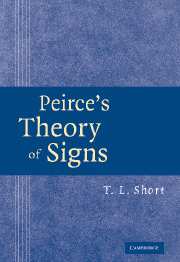Book contents
- Frontmatter
- Contents
- Preface
- Acknowledgments
- 1 Antecedents and Alternatives
- 2 The Development of Peirce's Semeiotic
- 3 Phaneroscopy
- 4 A Preface to Final Causation
- 5 Final Causation
- 6 Significance
- 7 Objects and Interpretants
- 8 A Taxonomy of Signs
- 9 More Taxa
- 10 How Symbols Grow
- 11 Semeiosis and the Mental
- 12 The Structure of Objectivity
- Bibliography
- Name Index
- Subject Index
- Frontmatter
- Contents
- Preface
- Acknowledgments
- 1 Antecedents and Alternatives
- 2 The Development of Peirce's Semeiotic
- 3 Phaneroscopy
- 4 A Preface to Final Causation
- 5 Final Causation
- 6 Significance
- 7 Objects and Interpretants
- 8 A Taxonomy of Signs
- 9 More Taxa
- 10 How Symbols Grow
- 11 Semeiosis and the Mental
- 12 The Structure of Objectivity
- Bibliography
- Name Index
- Subject Index
Summary
Our systematic exposition of Peirce's mature semeiotic begins, in this and the next two chapters, with its nonsemeiotic foundations. The chronological development of Peirce's thought is behind us; a few historical comments may nevertheless introduce our new approach.
The year 1902 marked a fresh start for Peirce. In that year, he presented an ‘architectonic’ ordering of the sciences, within which he announced a new science, of phenomenology. His phenomenological reworking of the three intermediate categories of the ‘New List’ had begun as early as 1885 (W5:235–47) and in succeeding years grew in intensity and refinement. But it was not until 1902 that he described what he was doing as a new form of inquiry, with a distinctive method and subject. This was the moment of a reordering and reconception of his entire philosophical enterprise. In the course of working out this architectonic, Peirce examined, at some length, the idea of final causation. Those discussions, too, were anticipated in various ways in earlier writings, but it was at this point that the idea of final causation assumed explicit central importance in Peirce's philosophy. All in one year, we have a new architectonic, a new science of phenomenology, and a new emphasis on final causation.
The word ‘phenomenology’ was introduced by J. H. Lambert in 1764 and was used by Kant and then by Hegel. Husserl first used the word in print in the second volume of his 1900–1 Logische Untersuchungen, thus preceding Peirce by a year.
- Type
- Chapter
- Information
- Peirce's Theory of Signs , pp. 60 - 90Publisher: Cambridge University PressPrint publication year: 2007



